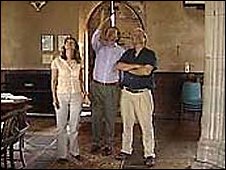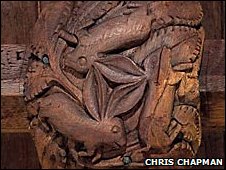
This plaster motif was found at Broadclyst
|
The next time you're visiting one of Devon's historic churches, take a close look at what's above your head. If you look carefully you may well spot an ancient symbol depicting three hares joined at the ears. Three Devon-based researchers have found the motif in 17 churches in the county and are looking for more. They've also visited sites in the Middle and Far East and the sign seems to crop up along a line, possibly an early trade route from east to west. The Three Hares Project was set up in 2000 by art historian Sue Andrew, who has been researching the symbol since the mid-1990s. She is joined in her quest by cultural environmentalist Dr Tom Greeves, and photographer and film-maker Chris Chapman. Recently, they travelled to France where they found the symbol in the Alsace area - again seeming to point to a route across Europe to Britain.

Sue Andrew, Chris Chapman and Tom Greeves
|
The earliest known examples of the motif date back to the 6th Century AD and are on the ceilings of Buddhist cave temples in Dunhuang, China - an important trading post. In Devon, the motifs are roof bosses on church ceilings. Many are medieval and made of wood. The earliest ones are dated at 1450. In all, there are 29 bosses which have been located in the 17 churches. It's believed there would have been many more at one time but these have been lost through the years. "We've obviously lost some," said Dr Greeves. "But what is left is representative of what was once there. "It's the fact that they are nearly all wooden carvings here which is most striking. They're remarkable."

The symbol in a church at South Tawton
|
There are some plaster ones as well, such as in Broadclyst - those are dated in the early 19th Century. In the Far East and Middle East, they are often found in ornate metallic carvings, or in glass or ceramic. Some are in textiles. The motif seems to have been important in the world's major faiths, spanning thousands of miles and at least 1,500 years - but no-one knows why: "The meaning, well that's very tricky ground," said Dr Greeves. "It's a wonderful mystery. Obviously they've got to have a meaning, but we're not sure what it is. Was the symbol given a special status in a religious context? It has been found in a Christian context, Buddhist, Islamic and Jewish.

The motif has even been found in Egypt
|
"We think we'll be able to show a Hindu context as well, although we've not been able to do that yet. There is an artistic element as well - it has a pleasing, attractive design - and there is some humour in there, with the three ears. "Unfortunately that doesn't provide us with any answers, but we're still working on it. Hopefully we will find out the meaning eventually." So what are the chances of finding some more in Devon? Dr Greeves believes it's still a possibility: "It's worth looking because some of the ones which came to light six or seven years ago hadn't been noticed before. "They are in dark recesses which are difficult to spot with the naked eye. "We've got people all over the world who are on the lookout for us, not just here in Devon. "If you see someone lying on the floor of a church with a torch in one hand and pair of binoculars in the other, they're probably looking for the three hares!" Find out more about the symbols and view photos of the motifs in Devon and around the world by visiting the team's Three Hares Project website.
|
~RS~q~RS~~RS~z~RS~51~RS~)
~RS~q~RS~~RS~z~RS~51~RS~)
Bookmark with:
What are these?